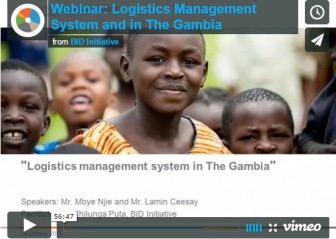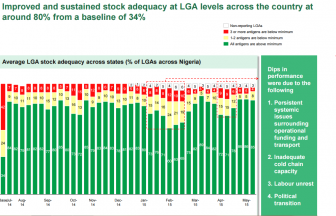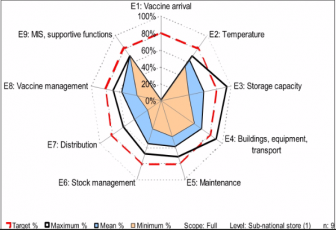Dec 4, 2017
Global Digital Health Forum Presentations 2017
Barcodes, Immunization Registry, Peer Learning, Software, Standards, Supply Chain, Tools, VIMS (Vaccine Information Management System)
Global
Sep 30, 2016
Save the Children: Further, Faster, Fairer
Progress in the coverage of immunisation services over the past decade has been impressive, with 86% of children globally now receiving basic vaccinations. However, there is cause for concern. Progress has recently slowed and the 2011–2020 Global Vaccine Action Plan is off-track. 19.4 million children under one year old – one in seven – are still excluded from the full benefits of immunisation. Further, Faster, Fairer shows that these excluded children are not evenly interspersed among other children who are being vaccinated. Instead they are concentrated in communities that are systematically excluded from progress.Sep 1, 2016
Experiences, Challenges, and Lessons Learned From an Immunization Demand Generation Project in Afar, Ethiopia
This report describes a pilot project that PATH conducted in the Afar Region of Ethiopia that aimed to increase vaccination coverage through social mobilization committees and communication activities. It examines the challenges to achieving vaccination coverage in the region, provides success stories demonstrating behavior change, and best practices and lessons learned.
Oct 28, 2015
Webinar: Logistics management system in The Gambia
Stock Management, Supply Chain
Gambia
The Better Immunization Data Learning Network (BLN) recently held a webinar entitled, “Logistics management system in The Gambia.” The presentation provided an overview of The Gambia, one of the countries with the best immunization coverage in the West African region.
Aug 31, 2015
Diagnosing Supply Chain Maturity: Supply Chain Compass Tool Helps Three Countries
An integrated supply chain is cost-effective, responsive, and reliable, and helps reduce stockouts. An integrated supply chain links all the actors involved in managing health products into one cohesive supply chain management organization. Countries typically move through an evolution process to achieve an integrated public health supply chain. While every country is different, the path to integration usually evolves, over time, through three sequential phases: (1) the ad hoc phase, where stakeholders have little common understanding of what the supply chain looks like; (2) the organized phase, where roles and procedures for basic logistics functions are clarified and sufficient financial and human resources are mobilized; and (3) the integrated phase, where people, functions, levels, and entities in the supply chain are linked and managed through an interconnected supply chain organizationAug 1, 2008
Introducing new vaccines in the poorest countries: What did we learn from the GAVI experience with financial sustainability?
This paper reviews the experience of the Global Alliance for Vaccines and Immunization (GAVI) in introducing hepatitis B and Haemophilus influenzae type b vaccines in the poorest countries, and explores how financing for immunization has changed since GAVI Fund resources were made available during its first wave of support between 2000 and 2006. The analysis of Financial Sustainability Plans in 50 countries allowed for some of the original funding assumptions of the GAVI approach to be tested against the realities in a wide set of countries, and to highlight implications for future immunization efforts. While the initial GAVI experience with financial sustainability has proved successful through the development of plans, and many countries have been able to both introduce new vaccines and mobilize additional financing for immunization, for future GAVI supported vaccine introduction, some country co-financing of these will be needed upfront for the approach to be more sustainable.Jun 22, 2015
Transportation: The Key to Effective Last-Mile Distribution in Zambia
An effective health service comprises many components, including a well-functioning supply chain; the availability of commodities at the health facility is one key part of the logistics system that ensures the end user can receive the health service they need. Delivering health commodities to the last mile, the point of service delivery, involves many processes and several modes of transportation. Commodities must come from manufacturers— often in foreign countries—to national warehouses, then to local storage units, and finally to the local health facility. In the countries where the USAID | DELIVER PROJECT implements supply chain programs, logisticians employ several models for the delivery of health supplies to service delivery points.
Jun 19, 2015
Webinar: Building real-time LMIS for the vaccine supply chain in Nigeria
eHealth, Stock Management, Supply Chain, Tools
Nigeria
The Better Immunization Data Learning Network (BLN) recently held a webinar entitled “Building real-time LMIS for the vaccine supply chain in Nigeria”. This webinar focused on building an LMIS for vaccine supply in Nigeria with an aim to acquiring a simple but impactful system. The speakers shared the stepwise approach they undertook and how they redesigned their system, adopting automation where it made sense. They discussed the challenges they faced, how they addressed them and the important lessons they have learned in the process of implementation.

May 19, 2015
Webinar: Cold Chain Management in Zambia
Stock Management, Supply Chain
Zambia
The Better Immunization Data Initiative Learning Network (BLN) recently held a webinar entitled “The Cold Chain Management in Zambia”. This webinar focuses on the practical aspects of managing the cold chain for a vaccination program in an environment that is less than ideal.
Apr 13, 2015
Vaccines, our shared responsibility
Peer Learning, Supply Chain
Global
The Developing Countries Vaccine Manufacturers’ Network (DCVMN) held its fifteenth annual meeting from October 27–29, 2014, New Delhi, India. The DCVMN, together with the co-organizing institution Panacea Biotec, welcomed over 240 delegates representing high-profile governmental and nongovernmental global health organizations from 36 countries. Over the three-day meeting, attendees exchanged information about their efforts to achieve their shared goal of preventing death and disability from known and emerging infectious diseases.
Jump in. Expand your knowledge.
Events
No upcoming events.
